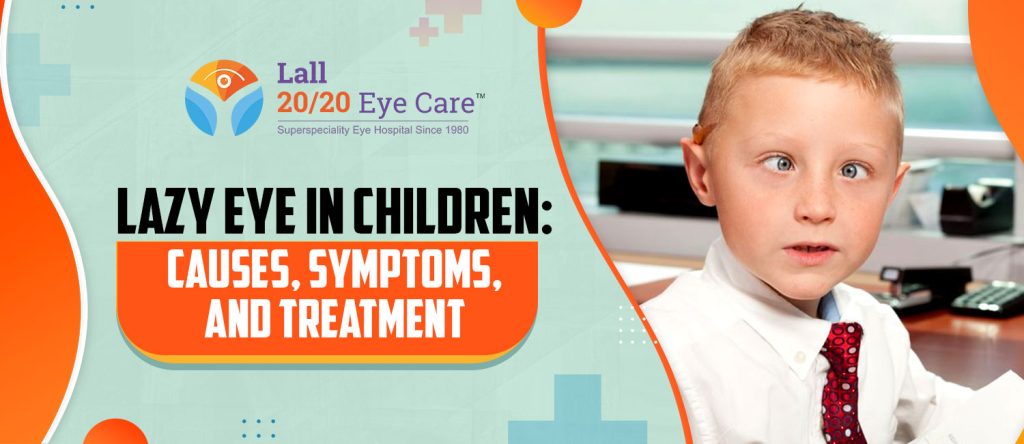Childhood is a phase in life that’s full of wonder – where every day brings new adventures and discoveries. But this fun-filled journey can sometimes be interrupted by unexpected health challenges. One such challenge is Amblyopia – a condition that can cast a shadow on this joyful phase.
Amblyopia, often called the ‘lazy eye’, isn’t just about eye misalignment; it is a complex vision disorder that can quietly compromise a child’s future. Therefore, the best pediatric eye specialist in Gurgaon brings this blog to help you know what causes this condition, what signs parents should watch for, and what can be done to help your child regain their visual clarity. So, let’s begin –
Understanding Amblyopia
Amblyopia is a common vision problem in children that affects their ability to see clearly through one or both eyes. This condition typically starts in infancy – from birth up to 7 years, and can persist if left untreated.
In it, one of their eyes has blurry vision which leads the brain to use the eye with clear vision. This reliance of the brain on the stronger eye worsens the vision of the weaker eye over time. Therefore, timely intervention by the best pediatric eye specialist in Gurgaon is extremely important in order to ensure that their journey through childhood remains vibrant and full of wonder.
Now, let us understand why this condition occurs –
Causes of Amblyopia
The main cause of Amblyopia is a difference in prescription between the two eyes, or sometimes, a misalignment where the eyes don’t work together. There are several other reasons why Amblyopia occurs –
- Strabismus (Crossed Eyes): Strabismus is a condition where the eyes are misaligned, which means that one eye may turn in, out, up, or down, not looking in the same direction. This misalignment can lead to Amblyopia, as the brain often suppresses the image from the misaligned eye to avoid double vision.
- Refractive Errors: These errors are vision problems that make it difficult to see things clearly. If they are not treated timely by the best pediatric eye specialist in Gurgaon, they may cause Amblyopia. These refractive errors are –
- Nearsightedness (Myopia): In this condition, your child finds it difficult to clearly see far away things.
- Farsightedness (Hyperopia): In this condition, it is difficult for the child to clearly see things kept close by.
- Astigmatism: This condition makes it difficult for the child to see things clearly at all distances.
- Structural Eye Conditions: Any eye condition during early childhood that affects the proper functioning of the eye can cause Amblyopia. Some of them are –
- Droopy Eyelids (Ptosis): In this condition, the upper eyelid droops or sags, potentially blocking the vision.
- Cataracts: Cataracts are cloudy areas that form in the eye’s lens, causing blurred or hazy vision. They can lead to loss of vision – if left untreated by the best pediatric eye specialist in Gurgaon.
Now, if you are wondering ‘how to know whether my child has got Amblyopia?’, the best pediatric eye specialist in Gurgaon has got you covered! Continue reading to find out the signs you should watch for to detect its presence –
Symptoms of Amblyopia
Detecting Amblyopia in a child can be tricky. Usually, it is not spotted until the best pediatric eye specialist in Gurgaon checks their eyes. However, if you notice the following signs, your child might be suffering from Amblyopia –
- They may bump into things, mostly on one side.
- They might prefer one side of their body.
- You might notice them closing one eye or squinting often.
- They might tilt their head to one side frequently.
- Their eyes might not align properly, or one eyelid may appear droopy.
So, What Are The Treatment Options Available For Amblyopia?
Fortunately, Amblyopia is treatable, especially when detected early. The best pediatric eye specialist in Gurgaon tries to stimulate and strengthen the weaker eye which repairs the connection between your child’s brain and both eyes. And, they do this via –
- Patch Therapy: In this, the stronger eye is patched for several hours each day, forcing the weaker eye to work harder and improve its visual acuity.
- Medicated Eye Drops: In some cases, medicated eye drops, usually Atropine, are prescribed by the best pediatric eye specialist in Gurgaon to blur the vision in the stronger eye temporarily. This encourages the weaker eye to improve its functioning – without affecting the vision of the stronger eye.
- Eyeglasses: If refractive errors are contributing to Amblyopia, eyeglasses with the appropriate prescription provided by the best pediatric eye specialist in Gurgaon can help correct them.
- Surgery: In cases of Amblyopia, surgery is rarely required. However, to solve structural issues like cataracts or Strabismus, surgical intervention may be necessary.
Preventing Amblyopia relies heavily on early detection and prompt treatment. Therefore, parents should stay vigilant and take their children for regular eye check-ups, especially if there’s a family history of Amblyopia or other eye conditions. Early intervention can significantly increase the chances of successful treatment and improved vision.
To know more about Amblyopia, book an appointment with the best pediatric eye specialist in Gurgaon at Lall Eye Care 20 20.

